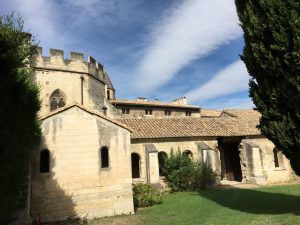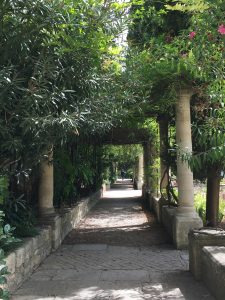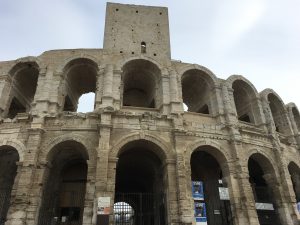We left Avignon by mid morning with several stops planned on our drive towards Arles. Just over the Rhone are two places on the must see list: La Chartreuse, a Carthusian Monastery, and the L’Abbaye Saint-Andre Gardens, behind the walls of the Fort. Both are located in Villanueve-lez-Avignon, which by itself is a charming hillside village with views across the Rhone of the Papal Palace and church spires.
La Chartreuse was built at the behest and generosity of Pope Innocnet VI after 1352. The monastery was initially meant to house just 12 monks, but over time it became the biggest Carthusian monastery in France, and was richly decorated. The same painter who adorned the chapels in the Papal Palace, Matteo Giovannetti, also painted the frescos in the chapel here. During the French Revolution it was severely damaged and looted, but restoration began in the early 1900’s and today it is not only a fine attraction for visitors, but it has taken on the role of a cultural center. There was an exhibition on display throughout the buildings, and it also serves as a year-round residence for artists working in the field of theatre. A good use for some fine spaces.
Just up the road and around the bend is the Abbatial Palace from the 17th and 18C, which is outstanding, but what the Abbaye Saint Andre is really renowned for are it’s gardens. Terraced gardens in Tuscan and Mediterranean styles lie amidst ruins of Romanesque churches and tombs from the early Middle Ages. And the views across the river to Avignon are really quite amazing. This space was also being used for exhibitions — sculptures were displayed throughout the Abbaye rooms, and in the garden as well.
Then it was back on the road for a short drive to the Pont du Gard, an ancient Roman aqueduct built in the 1st C (!) that crosses the Gardon River. The highest of all elevated Roman aqueducts, and, along with the Aqueduct of Segovia, one of the best preserved, it is a UNESCO World Heritage Sites.
The aqueduct bridge is part of the Nîmes aqueduct, a 31 mile system built in the first century AD to carry water from a spring at Uzès to the Roman colony of Nimes.Because of the uneven terrain between the two points, the mostly underground aqueduct followed a long, winding route that called for a bridge across the gorge of the Gardon River. The bridge has three tiers of arches, stands 160 ft high, and the whole aqueduct descends in height by only 41 ft over its entire length, which is indicative of the great precision that Roman engineers were able to achieve. The aqueduct carried an estimated 8,800,000 imp gal of water a day to the fountains, baths and homes of the citizens of Nîmes. It may have been in use as late as the 6th century, with some parts used for significantly longer, but a lack of maintenance after the 4th century led to clogging by mineral deposits and debris that eventually choked off the flow of water. Even after its use as an aqueduct ended, it continued as a toll bridge. It was really amazing to see up close; quite an engineering feat.
Then onto Arles, and a stay at the Jules Cesar Hotel. A city of art and history, Arles has nearly 100 buildings protected by the French gov’t heritage program, and both of the major Roman monuments are on the UNESCO list. The Roman theatre was built before the 1stC, and is currently being used as an amphitheater, and a tourist destination. The amphitheater/arena was built after the theatre, in the 1stC, and in its day could hold 21,000 specators to see fights and games. In the Middle Ages, it was transformed into a fortress, then reclaimed as an arena where today bull fights and games are organized. Saint Trophime’s church has a portal across the front that was carved at the end of the 12thC, and is one of the major examples of the Provençal Romanesque style.
Arle’s favorite artistic son is of course Vincent Van Gogh. Although he only spent a short time here in 1888-89 he painted some of his most famous paintings here, including Cafe Terrace at Night — that picture of the cafe with the yellow awnings. We of course went to see that cafe during our stroll around town and it has certainly leaned into the fame of the painting. There is a Van Gogh Foundation here in Arles which we will get to before we leave.
It was another long day, with lots of adventures, and then Sunday was done.

























It really is amazing to contemplate the reach the Romans had …